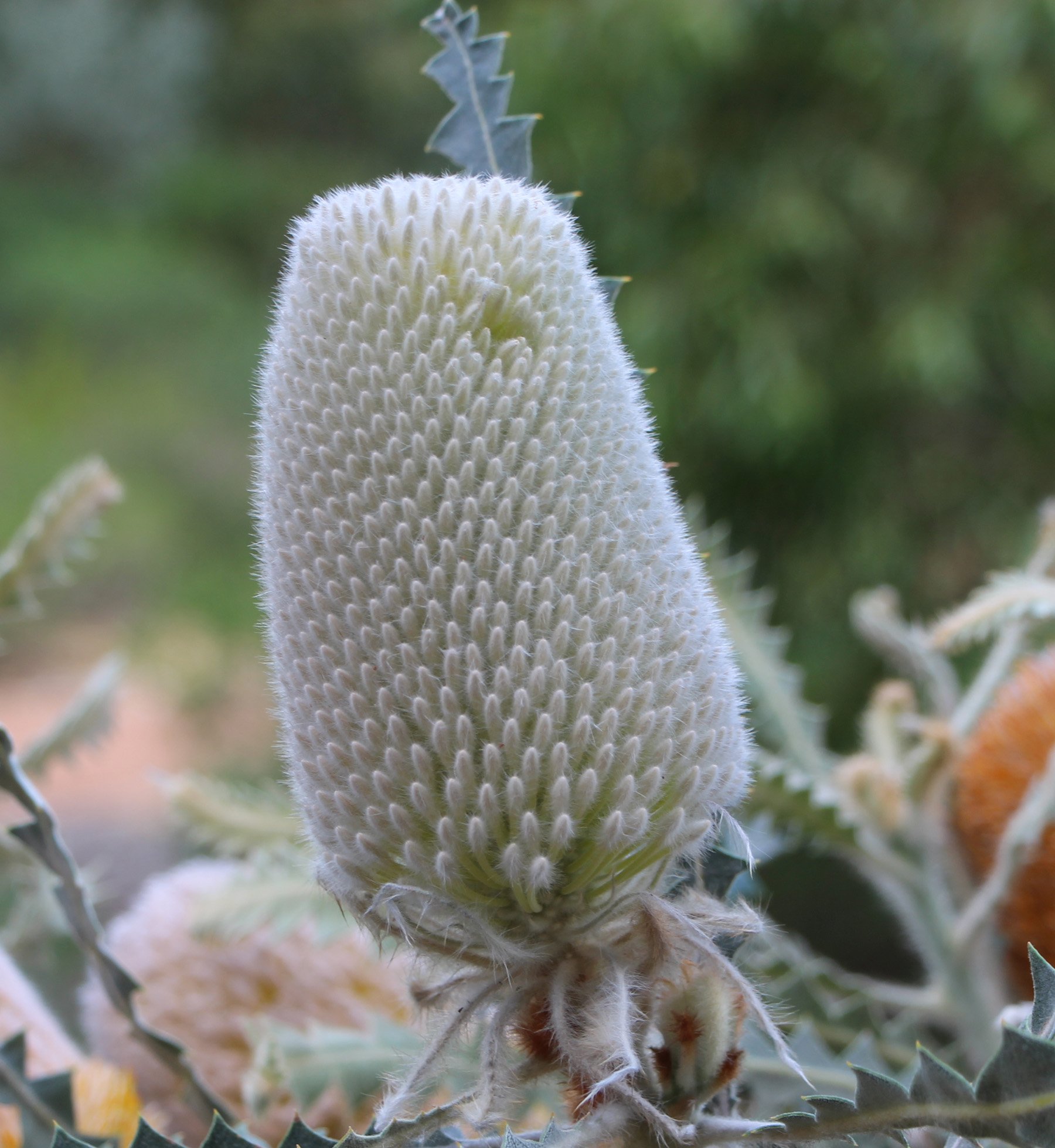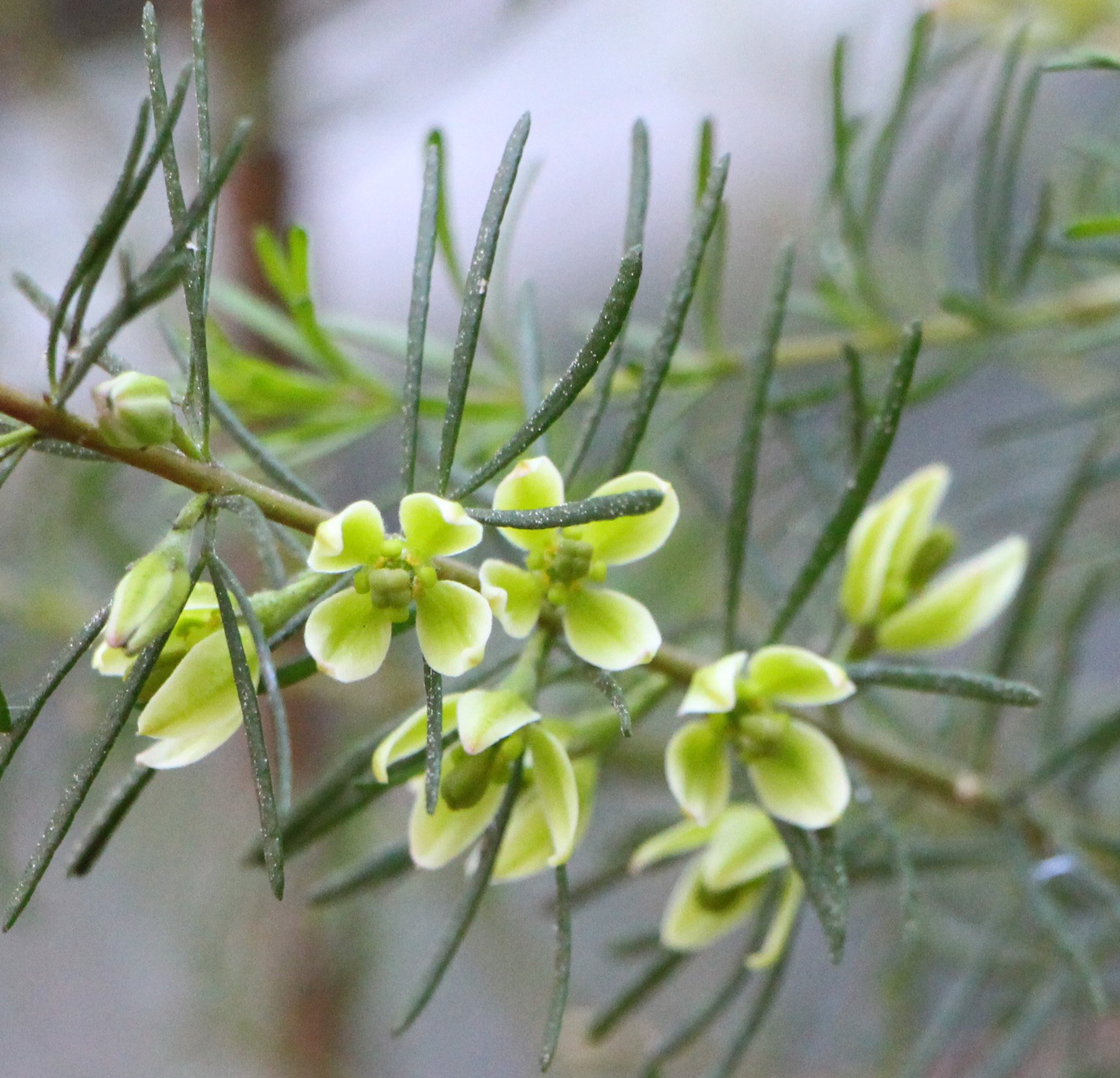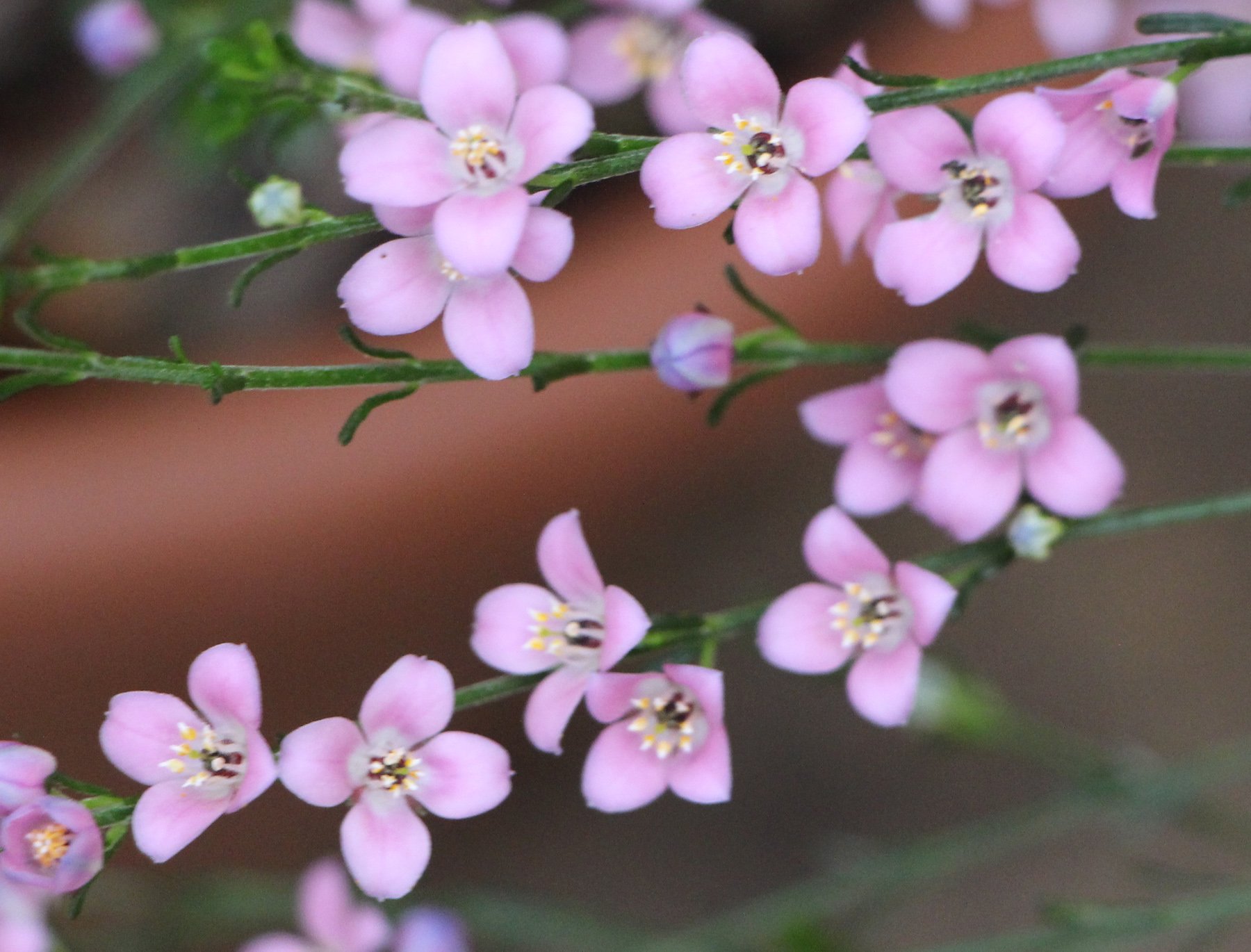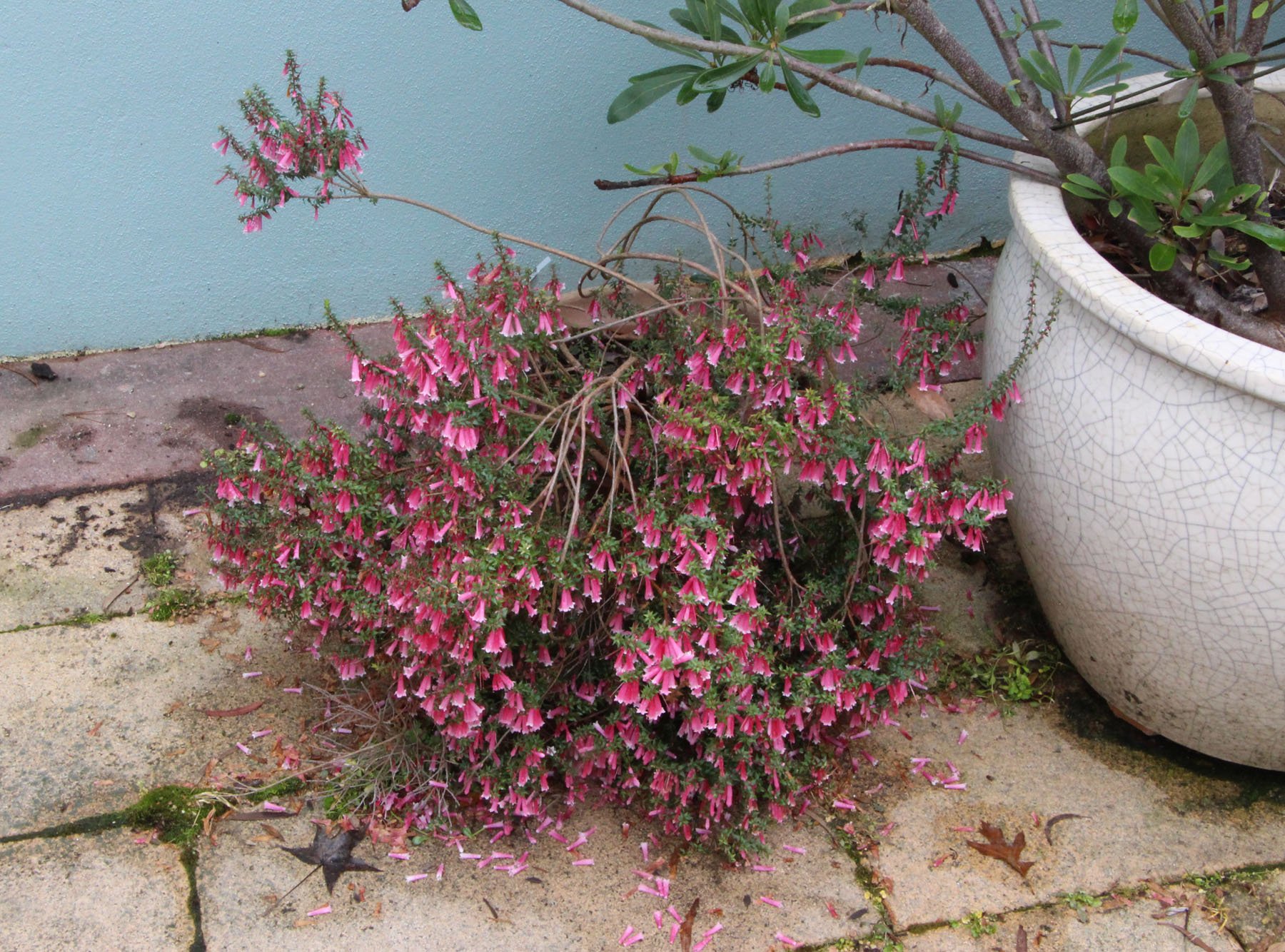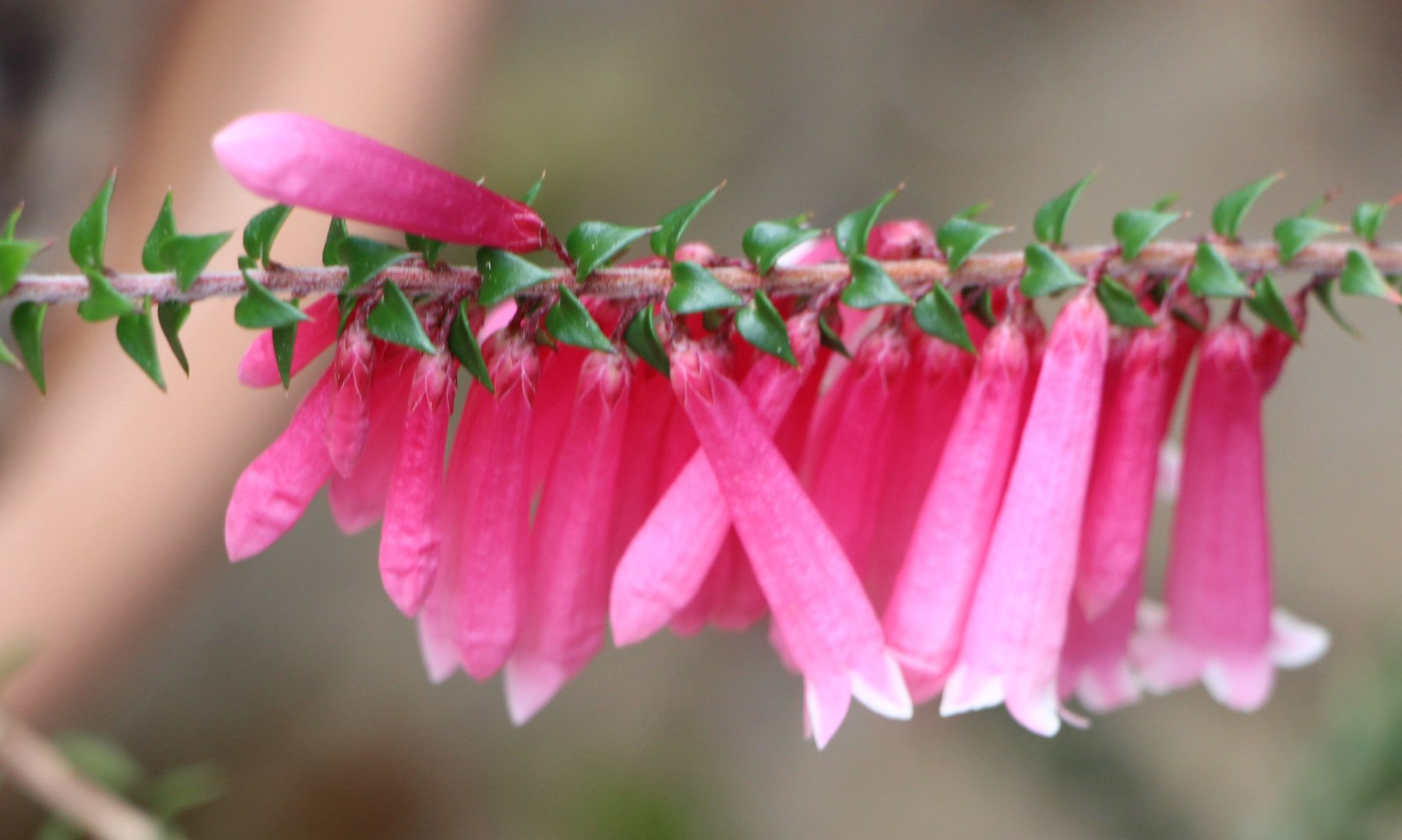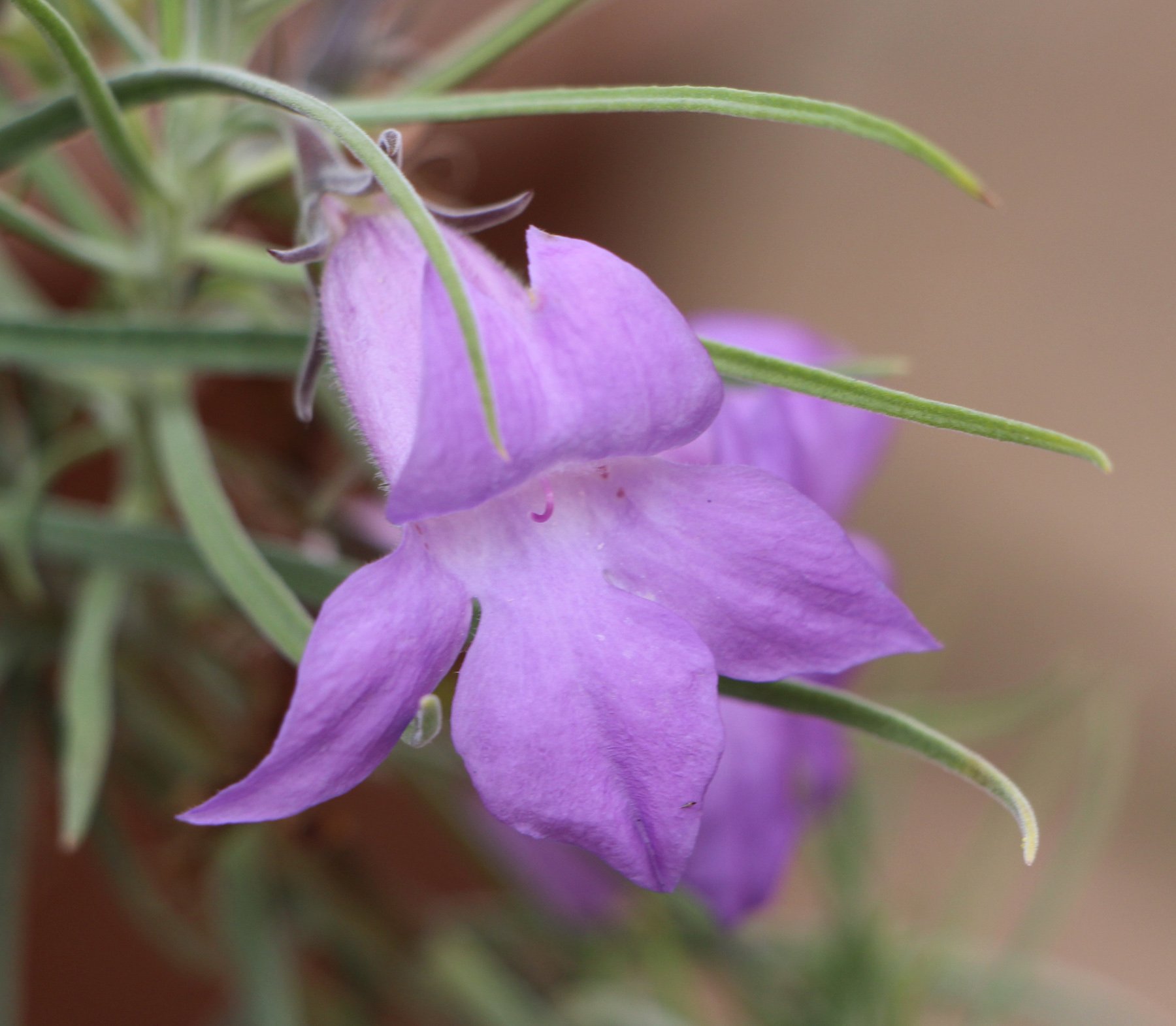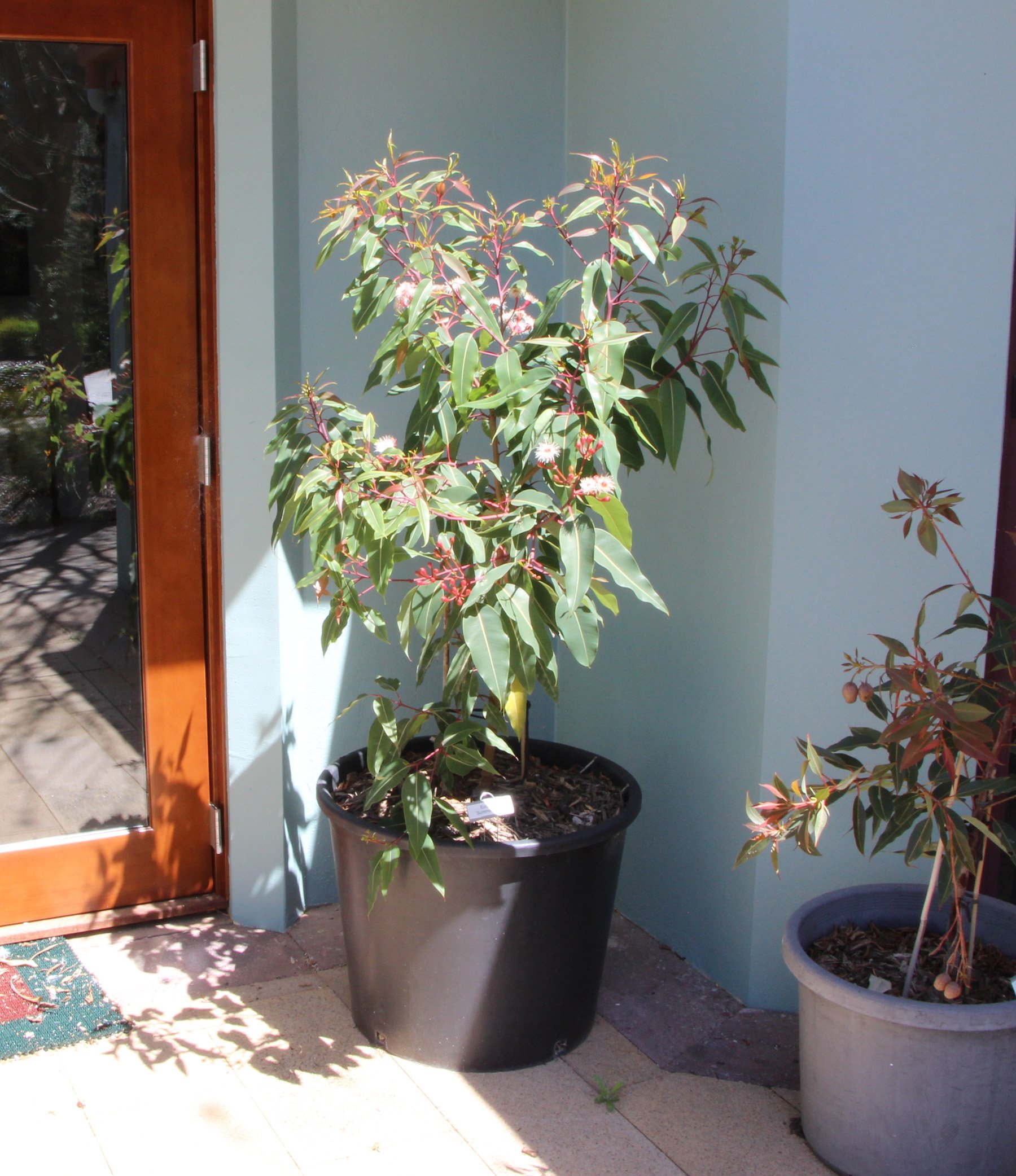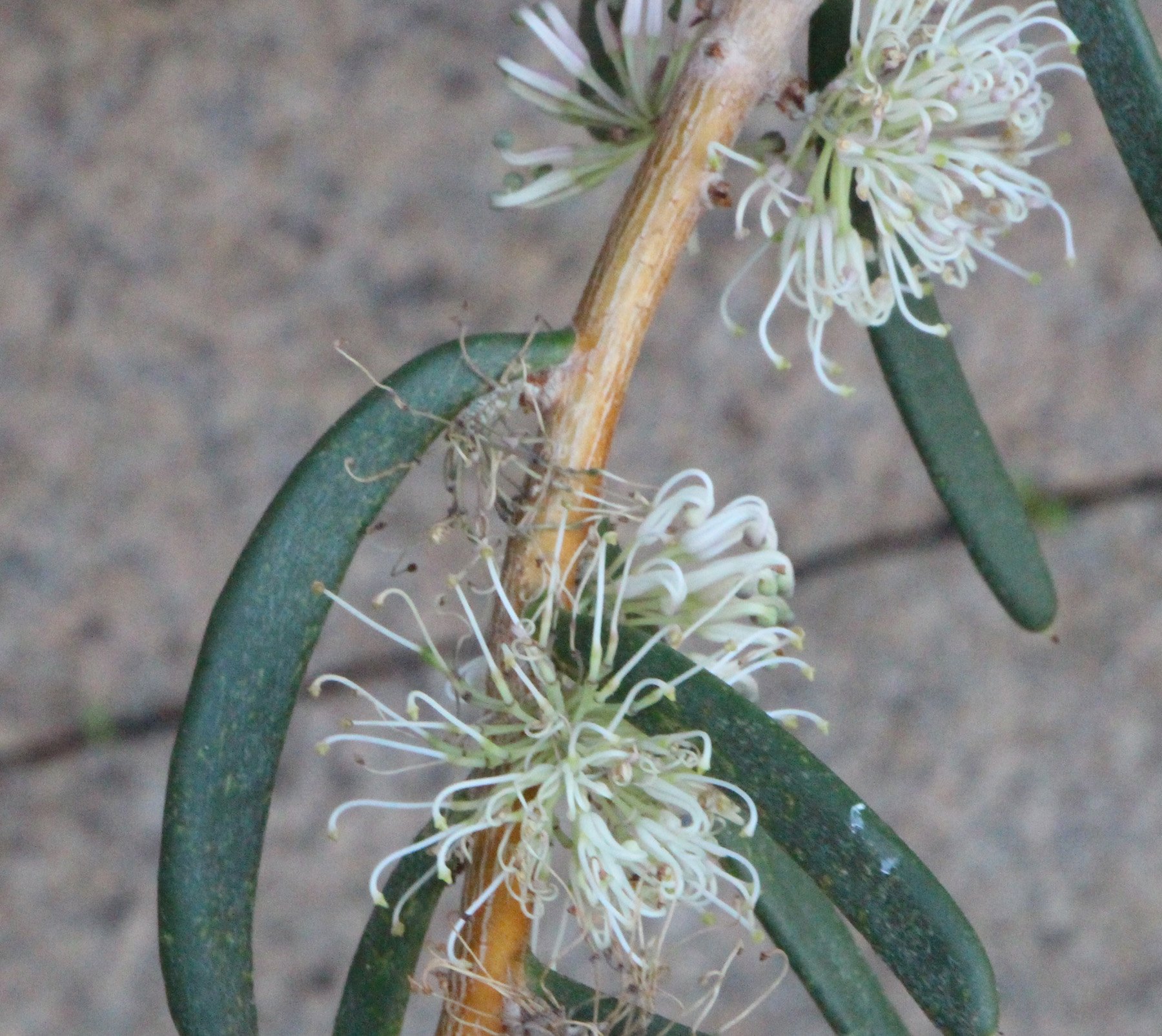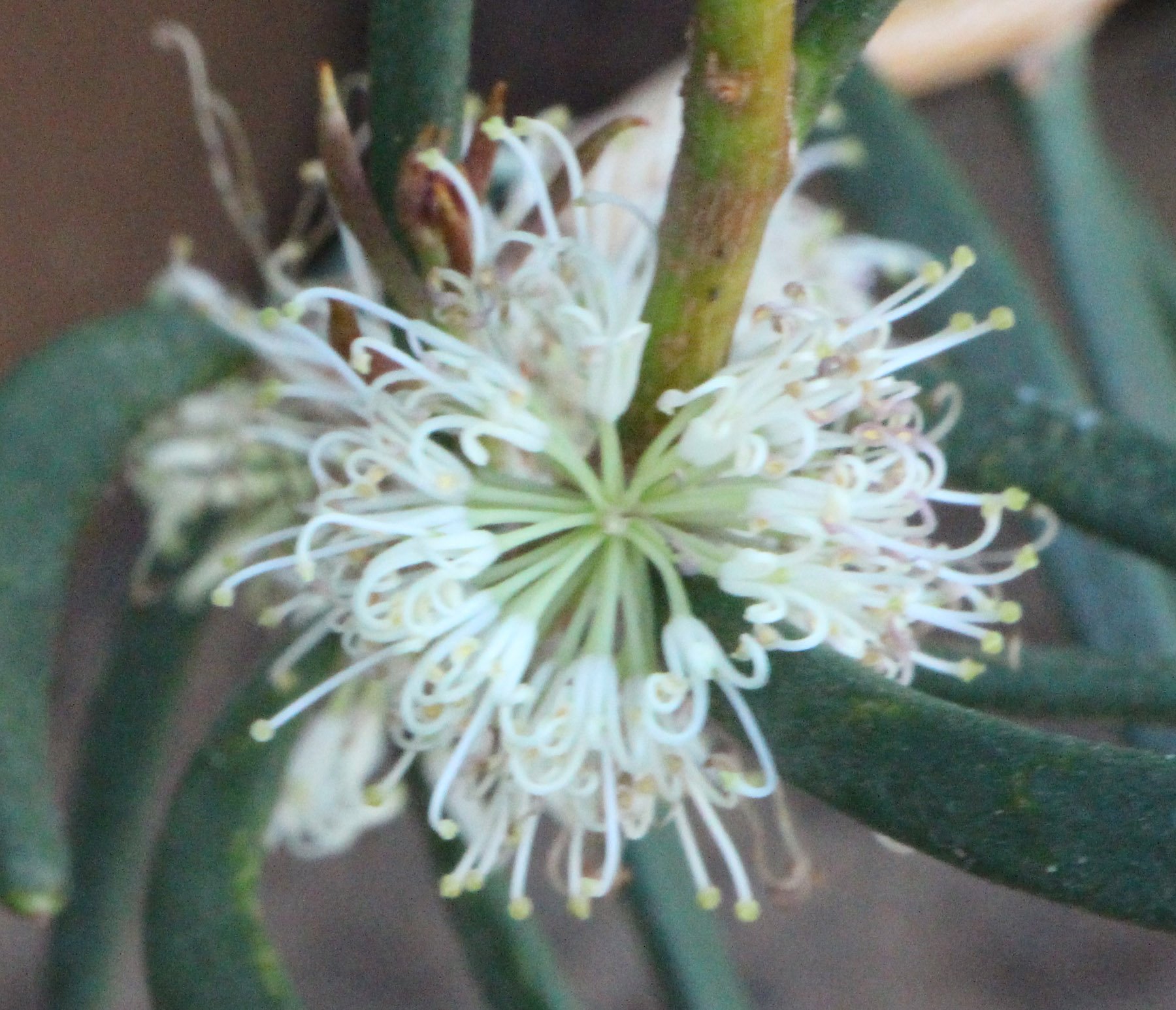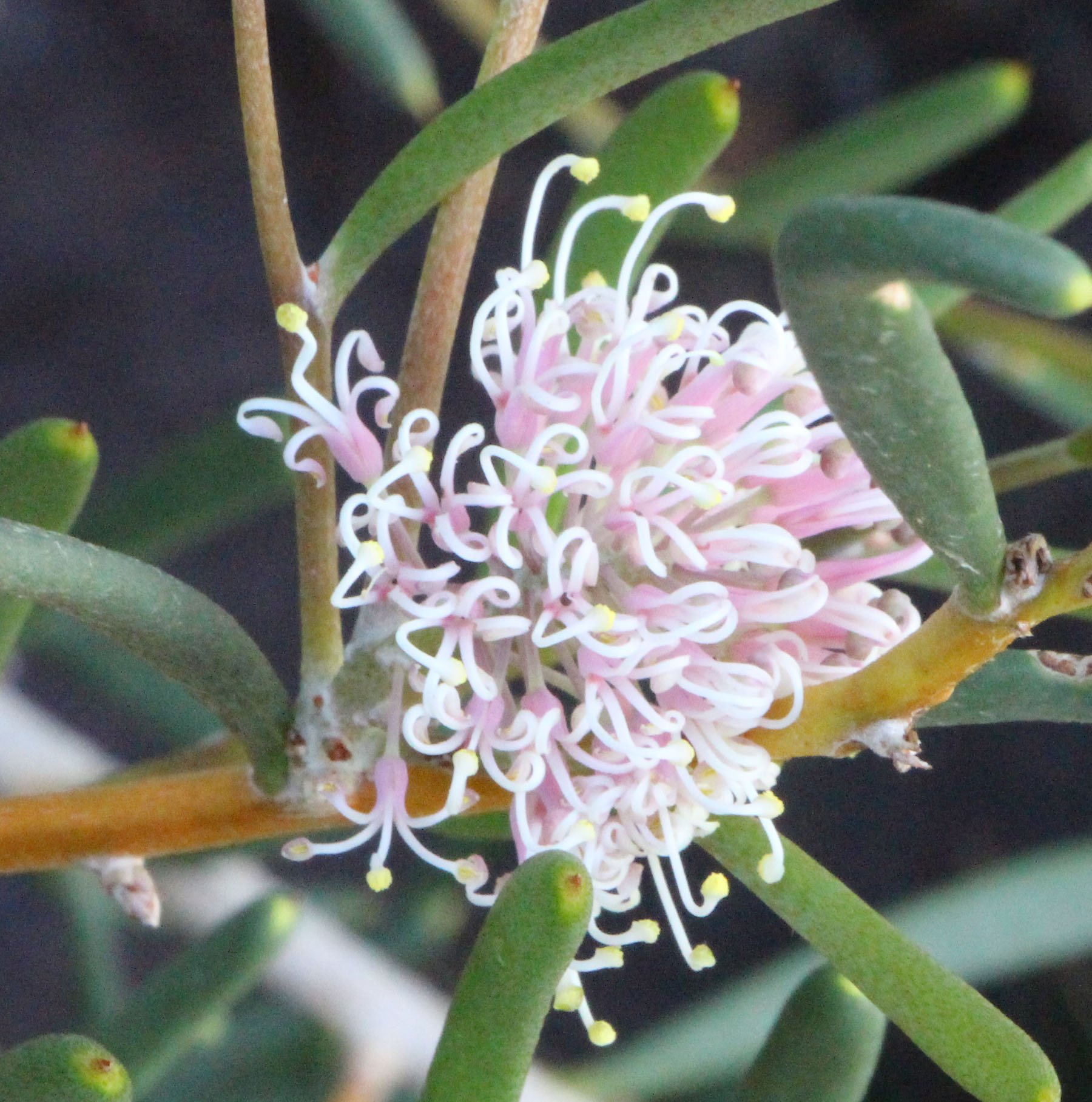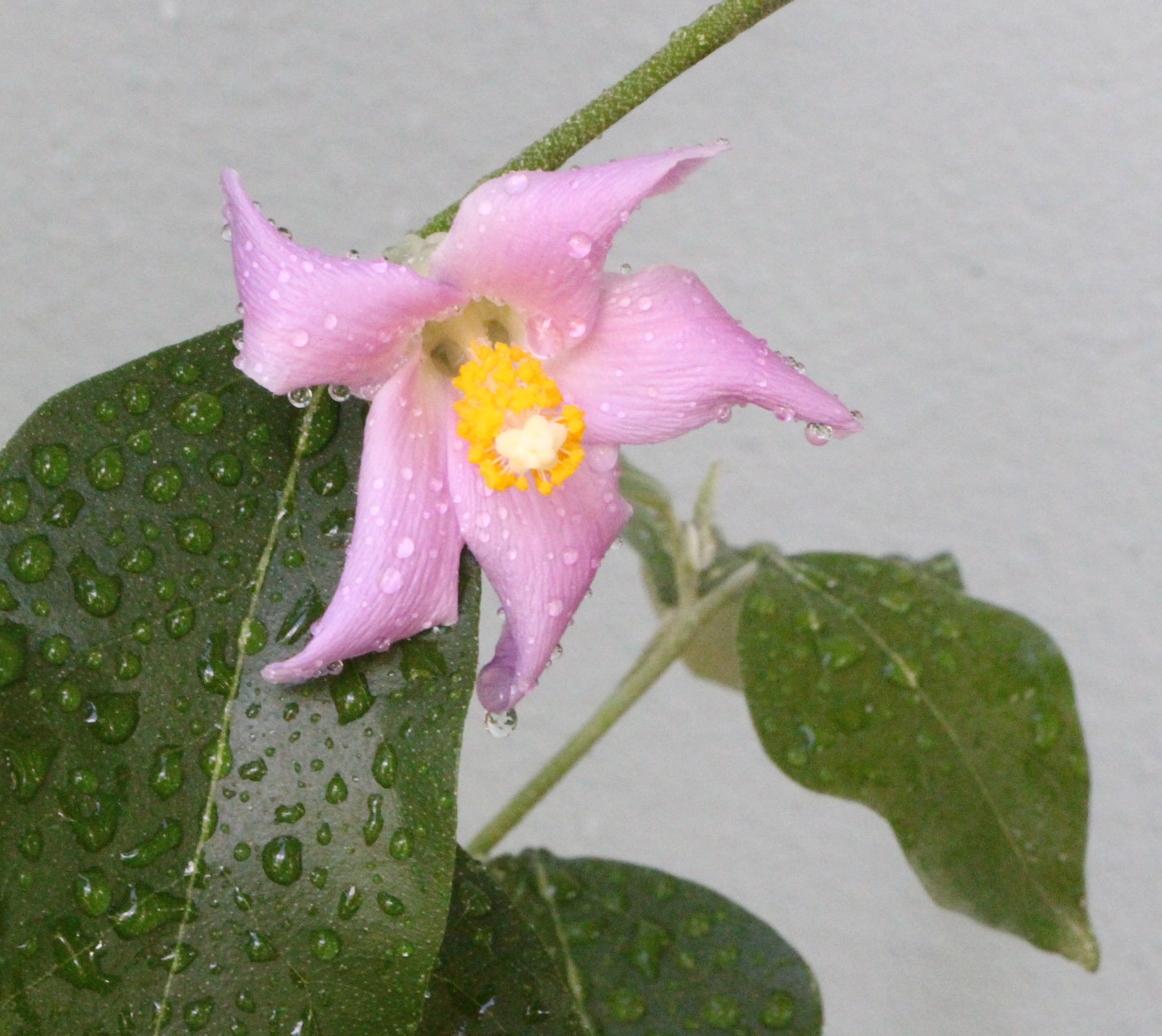Plants in pots
Banksia lindleyana
Acacia aphylla – Leafless Rock Wattle
We planted this open, much branched shrub to 2m., with leafless ,spiny, greyish branches and yellow ball flowers, followed by purplish grey seed pods, in a pot in September 2023. From WA (rare). Good drainage is important. We had previously planted two other plants in the garden, which were frosted off in their first winter. However this new plant did not thrive and was removed in December 2024.
Acacia binervia ‘Sterling Silver’ (photos above)
We planted this mounding plant, 1.8m high x 3-4m wide, tolerant of windy sites and almost any soil, as long as it is well drained, in a pot in November 2022 This plant has velvety, silver leaves and yellow rod flowers in spring and is both fast-growing and relatively long-lived (around 25 years). This plant was moved into the garden in November 2024.
Adiantum aethiopicum - Common Maidenhair Fern
We planted two of these small spreading ferns, to 0.5m high, with light green lacy fronds on slender glossy black stems, in a pot in June 2019. This plant needs moist soils (even clay) in sun or shade in a protected rockery spot, or is useful in a pot or hanging container indoors or out. We shear our plants once a year to take advantage of the beautiful new growth.
Anigozanthos ‘Bush Blitz’
We have planted two of these upright plants with orange/burgundy flowers, 70cm high x 50cm, wide, a a pot in December 2021. These clumping plants need very well drained soils in a sunny position. Probably best treated as an annual.
Anigozanthos ‘Bush Crystal’ (left two photos below)
We have planted two of these clumping plants, 80cm high x 50cm wide, with iridescent crimson flowers, twice, once in December 2019 and a second time in December 2022.. These plants like full sun and are best treated as annuals in Canberra.
Anigozanthos ‘Bush Dance’ (right two photos above)
We have planted two of these plants, in a pot, 60 cm high x 45 cm wide, with bright red and green flowers on distinctive red stems, several times from 2020-2023. This plant is not long lived and is best grown in a sunny position and is bird attracting. Cockatoos know I love this plant and trash it regularly.
Anigozanthos ‘Bush Diamond’
We have planted two of these compact plants, the first ‘white’ kangaroo paw, with a hint of pink, several times from 2020-2023.
Anigozanthos ‘Bush Tenacity’
We have planted two of these clumping plants, 60cm high and 45cm wide, with large gold flowers at the ends of strong upright stems with red hairs, in a pt, in December 2022. These plants like full sun and are best treated as annuals in Canberra.
Anigozanthos flavidus ‘Orange Cross’
We have planted two of these vigorous clumping plants, 1.2m high x 1.5m wide, with strappy leaves and deep orange flowers in a pot in November 2021. These plants need moist to dry well-drained soils, full to part sun. Our plants were trashed by ravens in February 2023.
Anigozanthos ‘Frosty Red’
We planted two of these clumping plants, 0.3-0.6m high and wide, with blue green foliage and deep red flowers, bred from A. rufus, in a pot in October 2022. One has flowered in frosty June 2024 and is a red beacon in the fog.
Asplenium australasicum
We planted this clumping fern which forms a ‘nest’ of glossy green leaves to 1.5m long and 20cm wide, in a pot, in September 2023. These plants need to be moist at all times and best grown in filtered light. Native to the coast of NSW almost down the Victorian border, extending north along the coast into Queensland to Cape York and into the tablelands and western slopes of NSW.
Attractocarpus (Randia) chartacea – Narrow-Leaved Gardenia (photos above)
We planted this bushy shrub, 2-3m high x 2-3m wide, with dark green glossy foliage and sweetly scented pure white flowers and bright red edible fruit in August 2019. This plant needs protection from direct sun.
Banksia grandis – Bull Banksia
We planted this spreading shrub, 1.5m high and 3m wide, with dark green toothed leaves and large yellow flower spikes, in March 2009. This species is native to southwestern WA. The seed that our plant was grown from was collected from Albany, WA near Mt. Clarence. We transplanted our specimen into a larger pot in April 2009 and this plant flowered every year until it suddenly died in the extreme heat of February 2020. We planted another specimen in January 2021 which died in October of the same year.
Banksia lindleyana (Photo below left)
We planted this shrub to 3m high, with grey fissured bark, yellow flowers with a red base, and hard fruiting cones, in May 2009. This plant is native to the area around Shark Bay, WA, where it grows in deep yellow sand on plains and in tall open shrubland. Flowers January to March. This plant is very popular with both birds and insects when in flower. In fact our resident Sulphur Crested Cockatoos have trashed this plant twice already, but it persists. We had to cut this plant back severely in November 2022 as it was devastated by cockatoos. We moved it away from the back door and it is recovering in 2024.
Banksia menziesii (dwarf) (Photo above right)
We planted this banksia, with toothed leaves and pink-mauve flowers in winter, in a pot in March 2010. This plant grows to height 2m, width 2m, and is native to the central west coast of WA. Our original plant died in 2023 and we have planted another in 2023 which was removed in September after winter damage.
Banksia ornata – Desert Banksia (Dukes Highway)
We planted this bushy shrub, 1-2m high x 1-2m wide, with small yellow flowers in October 2011. This plant is native to SA. We had great bloom each year from this plant and it attracted the New Holland Honeyeater to our garden. This plant died in the heat of February 2017. We have planted another one in February 2021 but birds nipped off all the foliage and it died.
Banksia plagiocarpa ‘Hinchinbrook’ – Blue Banksia (photos two below left)
We planted this shrub to 5m high, with a short trunk and spreading crown, in a pot in August 2019. The flowers pale blue grey to mauve in bud, then dull yellow when open. This banksia is native to Hinchinbrook Island, Queensland where it grows in sandy loam on rocky slopes. The red, velvety new foliage changes to rusty fawn, then green. The first plant died January 2023 and has been replaced, but this plant also died in 2024.
Banksia polycephala
We planted this evergreen shrub with striking lemon yellow flowers, in a pot, in February 2023. This species needs well drained soil, tolerates dryness and is usually frost resistant. Sadly died in October 2024.
Banksia praemorsa ‘Red Dawn’ (photos above right, last two)
We planted this bushy shrub in a pot in February 2020, 2-4m high x 2-3m wide, with burgundy flowers with green, yellow and pink as the flower develops. Banksia praemorsa is native to Albany WA. First flowers in June 2024.
Banksia verticillata – Granite Banksia
We planted this shrub, 5m high, much branched and spreading, with woolly orange and white flowers, in October 2019. This plant is native to southwestern WA, near Albany. Our specimen became too big for its pot in November 2014, so we planted it in a protected area of the garden, where it thrived until the severe frosts of June 2015, when it died. We have since planted another specimen in October 2019, which we kept in a pot, but it sadly died in February 2023.
Banksia victoriae - Woolly Orange Banksia (Photos above)
We planted, in a pot, in November 2013, Banksia victoriae, a tall shrub to about 5 metres high, with linear leaves, deeply lobed with triangular teeth and orange, ‘acorn shaped’ flower spikes. This plant grows in sandy soils in a restricted area northwest of Geraldton in Western Australia. We had many years of brilliant bloom from this plant but it sadly died in the rain of November 2022.
Blechnum nudum – Fishbone Water Fern (photo below left)
This widespread fern often forms large colonies in moist habitats, where it may develop a small trunk up to 30cm high. The upright fronds, which form a spreading rosette, are up to 1m tall. Native to southeastern Australia. We have planted many in the garden, where they thrive, but also planted three in a tub in October 2017.
Blechnum penna-marina – Alpine Water Fern (photo above middle)
We planted three of these groundcover ferns, 15-30cm high, with copper-coloured fronds when new., in a tub in October 2017. These are best grown in a moist shaded area in humus-rich well-draining soil. These ferns are widespread in Chile, Argentina, NZ, some Pacific islands and Australia. They quite quickly get crowded in the pot so we transplanted some to the waterfall, where they died, and others into the garden where they are growing well under protection.
Blechnum wattsii x minus (photo above right)
We planted three of these ferns, with deep green fronds forming thick clumps, and bronze new growth, in a tub in October 2017. These plants perform best in full to part shade, in a sheltered position with moist free draining soil. Do not allow to dry out.
Boronia anemonifolia (Photos above)
We planted this upright shrub, 0.7mhigh x 0.6mwide, with narrow leaves and many small pink to white flowers in March 2018.
Boronia clavata – Bremer Boronia (Photo below left)
We planted this shrub which grows to 1.5-2m high, with narrow aromatic leaves clustered along the stem. and many yellowish-green flowers first in August 2014. The first plant died, so we tried again in October 2019 with more success. Our plant has grown to 3m high in 2024. Storm removed half of the plant in December 2024.
Boronia coerulescens – Blue Boronia (Photo above right)
We have planted three of these shrubs to 50cm high, with short thick linear leaves and variable flowers from bluish to pink and white. This species is native to NSW, Vic, SA, and WA. The advice is that this plant is difficult to maintain for more than three years even in optimum conditions, but we have had two plants persist for over five years, blooming over long periods.
Boronia crenulata ‘Super Dooper’ (photos above)
We planted one of these shrubs, 1m x 1m, with light green foliage and candy pink star flowers in September 2020. This plant is tolerant of only light frosts and must be protected in Canberra.
Boronia cymosa – Granite Boronia
We planted one of these shrubs with pink flowers in spring in clusters on long stems, in a pot, in April 2023. It has grown vigorously to 1m high. This plant prefers well drained soil and is moderately hardy in areas of winter rain. Native to southwestern WA.
Boronia denticulata (photos below, left two)
We planted two of these shrubs, 1m high x 1m wide, with bright green aromatic leaves and many showy pink flowers, in 2011 and 2018. The first plant died of heat stress in January 2018, but the second persists, despite the horrors of summer 2020. This species is native to southwestern WA.
Boronia filifolia - Slender Boronia (photos above, right two)
We planted one of these dome shaped shrubs, 0.3-0.5m high x 1-3m wide, with pink flowers in September 2020. The dainty flowers are borne over long periods. This species is native to Victoria and South Australia. Died over winter 2023.
Boronia floribunda (photo below left)
We planted one of these small shrubs, with fern like leaves and large pink flowers in November 2019. This species is native to the area around Sydney, NSW. Removed in December 2022 for failure to thrive.
Boronia heterophylla ‘Blue Waves’ (photos above middle and right)
We planted this evergreen shrub, 1m high and wide, with dark green aromatic foliage and mauve-blue bell shaped flowers, in a poot in October 2021. This plant will tolerate only light frosts. and was eaten in half by birds In October 2022 and moved into more protection. Great flowering in 2024.
Boronia heterophylla red
We planted this upright shrub, 1-2m high x 1-2m wide, with fine, bright green aromatic foliage and red bell shaped flowers, in a pot in October 2021. This plant prefers light free-draining sandy soils in partial sun or dappled shade. Protect from hot winds. Native to southwestern WA.
Boronia heterophylla x B. molloyae ‘Carousel’
We have planted two of these shrubs, 2m high x 1.5m wide, with fine needle-like aromatic foliage and many fragrant pink bell flowers, which deepen to red and last for a long period of time, in a pot in November 2019 and May 2021. This plant prefers a cool, partly shaded position in moist, well-drained soil. Prune after flowering and keep moist. Our first plant died in January 2020. The second plant produced its first flowers November 2021. This cultivar is a very lax plant which blooms profusely but droops too much - need to stake successfully.
Boronia keysii (Photo below left)
We planted this rare species of boronia from southeastern Queensland, height to 2m, with aromatic foliage and pink, star-shaped flowers in November 2019. This plant was lost to science for 62 years then rediscovered in 1971. Our first brilliant plant died after being repotted, but the second one, not nearly as floriferous, planted in April 2023, persists.
Boronia ‘Lipstick’ (Photo above right)
We planted this hybrid boronia, B. crassipes x B. heterophylla, height 1-2.5m x 50-75cm, an upright, evergreen shrub with narrow, aromatic leaves and many large, purple-pink bell shaped flowers in September 2020. Died in January 2024 from wet feet as the drainage was poor - mea culpa.
Boronia ‘Magenta Stars’
Boronia heterophylla ‘Moonglow’ x B. pulchella. We planted this bush, 1m high and wide, with magenta star flowers which fade to white and slender aromatic leaves, in a pot, in September 2023. Needs full sun or part shade in free draining neutral or acidic soils. Developed by King’s Park Botanic Gardens.
Boronia megastigma ‘Dark Prince’ (Photo below left)
We planted this version of the popular Brown Boronia, Boronia megastigma, height 80cm x width 50cm, a compact plant with dark brown flowers with yellow inside, in November 2019. This plant has a magnificent perfume, but is what we call a fainter – needs regular water.
Boronia megastigma ‘Lutea’ (Photo above right)
We planted this shrub, 1.5m high x 0.6m wide, with fine aromatic foliage and fragrant yellow flowers in September 2018.
Boronia molloyae (photo below left and middle)
We have planted several of these boronias which grow in sandy soils in southwestern coastal regions of Western Australia. This slender shrub has red-pink flowers and highly aromatic foliage.
Boronia muelleri soft pink – Forest Boronia (photo above right)
We planted this shrub, 1.2-2m x 1.2-2m wide, with reddish branches and aromatic green pinnate foliage, dark pink buds followed by pink flowers in November 2019.
Boronia muelleri x B. pinnata (photo below left)
We planted one of these hybrid boronias, 1.5m high, with fragrant leaves and light pink to purple flowers in September 2020. This plant needs a sheltered position.
Boronia pinnata (photo above right)
We planted one of this variable species, height 1.8m x width 1.5m, with ferny scented leaves and star-shaped pink flowers in November 2019. Died December 2023.
Boronia ‘Pixie’
We planted this shrub, 2m high and 1m wide with aromatic foliage and pink flowers in spring in September 2020. Died suddenly in April 2024 as was very dry due to soil that had become hydrophobic.
Boronia ‘Plum Bells’
We planted this hybrid boronia, B. ‘Moonglow’ x B. megastigma, 1m high and wide, bred by King’s Park, Perth, with many plum bells and slender aromatic leaves. in November 2020. This plant was also in soil that had become hydrophobic and was immersed in a trug in April 2024.
Boronia (pinnata x muelleri) ‘Showoff’
We planted this small plant with dainty aromatic foliage and soft pink star flowers, in a pot in January 2023. Needs a well drained soil that remains moist all the time – morning sun and afternoon shade is ideal. Cut back by one third after flowering to keep bushy - very vigorous.
Brachychiton bidwillii - Little Kurrajong (Photos above)
Brachychiton bidwillii, planted in a pot in 2013, has grown to 3 metres tall. This plant needs protection from the frost as it comes from dry rainforest from southeastern Queensland to Bowen in the north. The foliage is one of its distinctive features with five lobed felty leaves reminiscent of a human hand. The flowers are bell shaped, and vary from orange-red to salmon pink held in clusters. As the plants age, flower production increases, and after eight years or so they may produce spectacular massed displays of hundreds of flowers almost covering the trunk, adding to the usual display clustered along twigs and branches. This plant grew too large for its pot and was hard to move around, so was replanted in the garden in February 2024. Happily it has flowered profusely on bare branches in December 2024.
Cerapetalum gummiferum dwarf – NSW Christmas Bush
We planted this compact bush, height 1m, width 1m, with creamy white flowers and red calyces, in November 2012. This plant was blasted by the frost in August 2014, but has recovered somewhat. Given away in 2024.
Chorizema cordatum – Flame Pea (photo below left)
We have planted five of these shrubs, to 1m high, with sprays of pink and orange pea flowers and heart-shaped leaves, from 2009 to 2020. This plant is somewhat frost-tender and will not survive in the ground in our garden - they are also susceptible to extreme heat and need some shade. This species is native to southwestern WA. Brilliant colours.
Chorizema varium – Limestone Pea (photo above right)
We planted this spreading shrub, 30cm high x 70 cm wide, with attractive holly-like foliage and profuse orange and red pea flowers in August 2019. This plant prefers part shade and only tolerates light frosts. This endangered plant is native to the Swan Coastal District of WA.
Citrus hybrid – Rainforest Pearl
We planted Rainforest Pearl, Citrus australasica var. sanguinea, in June 2012. The fruit is finger sized and has a fragrant thin green skin flushed with crimson, containing lime-flavoured citrus pearls. Given away in 2024.
Citrus hybrid – Red Centre Lime
We planted ‘Red Centre’, a cross between a finger lime and a Rangpur lime with lustrous red, egg shaped fruit about the size of a cumquat, in June 2012. This plant has vicious spines.
Citrus hybrid – Sunrise Lime
We planted Sunrise Lime in June 2012, a cross between a finger lime and calamondin, with an elegant pear shaped golden fruit that is juicy and sharp in flavour. The fruit can be eaten whole as the skin and pith is sweet. This plant makes great marmalade.
Correa ‘Canberra Bells’
We have tried seven specimens of this shrub, growing to 1m x 1m, with red and cream bell flowers from late summer to winter. The plants in the ground have not done as well for us as one we planted in a pot in March 2017. The plant in the pot blooms prolifically over a long period. Perhaps mercifully the plants in the ground were squashed flat by the fall of a pine in July 2016.
Corymbia ficifolia ‘Calypso’
We planted this grafted tree, 6m high x 4m wide, with dark green foliage, watermelon pink flowers and spectacular gumnuts, in April 2024. Needs well drained soil and full sun.
Corymbia ficifolia ‘Mother of Pearl’ or ‘Precious Pearl’
We planted this grafted plant, 0.7m high x 0.4m wide, with dark green foliage, very pale pink flowers and spectacular gumnuts, in April 2024. Needs well drained soil and full sun. Nipped off completely by cockatoos in July 2024.
Corymbia ’Summer Red’
C. ficifolia x ptychocarpa. Grafted. We planted this spectacular small hybrid tree, 6-8m high, with many brilliant red flowers with yellow centres and gold tipped stamens, followed by ornate gumnuts, in March 2024. Needs full sun position in well-drained soils.
Crowea exalata
We planted this rounded hardy shrub, 0.7m high x 0.7m wide, with linear leaves and star-like white to pink flowers in a pot in March, 2022. This plant will thrive in most positions in well-drained mulched soils. Native to southeastern mainland Australia. Repotted in March 2023 and has grown well and flowered over a long period.
Crowea exalata ‘Profusion’
We planted three of these dainty evergreen shrubs, 1m high and wide, with aromatic leaves and a profusion of pink star flowers, in a pot, in August 2019, These plants need a cool, partly shaded position in moist well-drained soils. First blooms November 2019. One died in the heat February 2020, another in the rain of March 2022, but one persists.
Crowea saligna ‘Large Flower’ (photo above)
We planted three of these small shrubs in pots, 80cm high x 60cm wide, with large pink flowers and aromatic foliage, in a pot, in February 2020. Native bees and butterflies are attracted to this plant. One died in March 2022.
Dampiera diversifolia ‘Southern Blue’ (photos above)
We planted two of these hardy groundcovers, prostrate to 2m wide, with neat, bright green foliage which suckers, and blue fan-like flowers, in a pot, in December 2021. Needs a sunny to part shade position with well drained soils. Tolerant of light to medium frosts. Prune after flowering.
Diplolaena grandiflora (grafted) (pot)
We planted two of these shrubs, height 2m x width 1.5m, with woolly grey leaves and large orange to red flowers surrounded by green bracts in January 2010 and October 2017. The first one died in March 2010, but the second is still flowering well., despite being attacked by choughs.
Dypsis lutescens - Golden Cane Palm, Areca Palm
We planted two of these palms, native to Northern Queensland, in June 2019. We have them indoors and hope that they do not reach their maximum size of 6-8m high x 2-2.5m wide. So far they are 2m high and 1.5m wide with very decorative dissected foliage.
Epacris impressa (Bega Form) – Common Heath
We planted two specimens of this species, with narrow pointed foliage and masses of red tubular flowers, in 2012 and 2019. The first one died in the heat of January 2017, but the second one persists. This plant is the floral emblem of Victoria. Last one removed October 2022.
Epacris longiflora
We planted this shrub, 0.5-1.3m high x 1m wide, with small pointed leaves and long red bell flowers with white tips, in September 2010 and March 2019. The first plant was a fantastic plant from Dawn Barr which did not appreciate being repotted, and then died in February 2017. This plant is native to heath and open forests of New South Wales and southern Queensland and blooms every year at Xmas.
Epacris reclinata (photos below)
We planted this shrub, 0.6-1m high x 0.5m wide, with small prickly leaves and pink to red bell flowers in August 2019. This plant is native to the Blue Mountains, NSW. Flowers well over a long period starting in June. Browned off and removed March 2025.
Eremophila abietina – grafted – Spotted Desert Bush
We planted this stiff sticky shrub, 2m x 2m, with narrow green leaves and large purple flowers., followed by showy metallic sepals which remain on the bush after the flowers have fallen off, in November 2017. This plant is native to central WA and tolerates only light frost so must be protected in Canberra. Died over winter 2022.
Eremophila calcicola
We planted this hardy shrub with green foliage, 0.5m high x 1.5m wide, with green flowers throughout the year, in a pot, in November 2023.
Eremophila cuneifolia - grafted (photos below left and middle)
We planted this bushy shrub, 1.2-1.5m high, with many mauve/pink flowers, in February 2018. Be careful to remove the Myoporum rootstock. This plant is native to the Pilbara region, WA.
Eremophila ferricola ‘Tallering Peak’ (photo above right)
We planted this spreading shrub, 1.5m high, with green flowers in May 2020. This plant is native to the region around Geraldton, WA. Died February 2023.
Eremophila foliosissima (photos below left two)
We planted this dense shrub, 0.75m high x 1.5m wide, with evergreen leaves and purple flowers in October 2019. Prefers full sun with good air movement and is frost tolerant. . The name means many leaved and the plant is native to central WA.
Eremophila glabra ‘Canning Stock Route’
We planted this upright shrub, 1-1.5m x 1m wide, with silvery grey foliage and red tubular flowers late winter and spring and sporadic throughout other times of the year, in a pot, in May 2023. This is a tough shrub for difficult areas. Grows best in full sun but will tolerate part shade in most soils.
Eremophila ‘Lipstick Pink’ - grafted (photos above right two)
We planted this upright shrub with attractive grey foliage and lolly pink flowers in a pot in December 2019. This plant is from central WA and grows to a height of 1.5m.
Eremophila granitica (photos below)
We planted this shrub, height 1.5m, with pink cup flowers in May 2020. This plant is widespread and common in the area between Kalgoorlie and Murchison, WA. Died in the rain of March 2023.
Eremophila lachnocalyx
We planted this low growing shrub, 1.75m high, with interesting grey foliage and purple flowers, in a pot, in March 2021. Needs good air movement and a warm spot – tolerates only light frosts. Native to central WA. First flowers 4/21. This plant does not like all the rain of December 2021-January 2022 - looks poorly.
Eremophila pinnatifida
We planted this compact shrub, 1.5m x 1.5m, with pale to deep blue flowers, first in September 2009 and then in March 2014. This species is native to central WA. First plant died over winter 2010 and the second quite promptly too.
Eremophila platycalyx subsp. platycalyx
We tried one of these shrubs, 2.5 x 2.5m, with cream flowers and pink sepals, in the ground in May 2017, but it died the next year. We are now trying one in a pot, planted May 2020. Still no luck with this plant – died in the rain of November 2021.
Eremophila (polyclada x divaricata) ‘Summertime Blue’
We have planted five of these open shrubs, 2m high x 1.5m wide, with narrow shiny dark green foliage and large showy blue flowers in summer. Only one remains in a pot, planted in August 2019. Full or part sun in most soils in dry spot with overhead cover. Will take waterlogging. Tip prune. Native to the flood plains of the Murray River in NW Victoria.
Eremophila punicea – Crimson Emu Bush
Name means reddish. We planted this shrub, 0.3-0.7m high x 0.5m wide with grey leaves and white, pink or crimson flowers, in a pot, in March 2022. Tolerates medium frosts, does best in full sun with good air circulation. Native to central WA. First pink flowers in September 2022. Does not tolerate rain well.
Eucalyptus erythrocorys – Illyarie
We planted this small tree, 8m high, x 3-8m wide, with smooth pale bark, bright yellow flowers with a grooved red operculum and large angular fruits in November 2010, in the ground, and October 2017 in a pot . The potted plant survived while the one in the ground died in December 2016, despite being covered in winter. This plant is native to the drier areas. of WA and grows very well in Perth. Discarded for failure to thrive January 2023.
Eucalyptus erythronema ‘Hot Threads’
We planted this multistemmed mallee, 7m high x 3-4m wide, with waxy white or reddish trunk and large blood red blossoms, in July 2010 in the ground, and October 2017 in a pot. The potted plant survived for some years but was discarded January 2023.
Eucalyptus ficifolia ‘Dwarf Orange’ grafted (photos below left three)
We planted this dwarf selection of WA flowering gum, 3m high x 3m wide, with vermillion trusses of bloom in February 2020. One branch was removed by cockatoos in September 2020, but the plant has flowered well. Moved to garden under cypress March 2024.
Eucalyptus ‘Summer Beauty’ grafted (photos above far right)
We planted this hybrid gum, E. ficifolia x E. ptychocarpa, with bronze new foliage, large pale pink flowers with gold tipped stamens and yellow centres in December 2020. This plant was moved to the garden in September 2024.
Eucalyptus tetraptera – Square Fruited Mallee
We planted this open shrub, 3m high x 4m wide, with glossy leathery leaves and red or pink flowers with a large square red calyx in November 2019. This plant is native to the area between Albany and Esperance, WA. Half eaten by cockatoos in May 2021 and died in the rain February 2022.
Gastrolobium praemorsum ‘Brown Butterfly’
We planted this groundcover, 30cm high x 1.5m wide, with unusual bronze to burgundy ‘butterfly wing’ foliage with green margins, in a pot, in February 2020. This plant has large red pea flowers in spring and summer and in our climate, needs quite a bit of shade. We also planted one in a shady spot the ground in March 2020. One in pot died December 2022. Only one remains – the one in the ground.
Gossypium ‘Flirtatious’ (photos above)
We planted, in a pot, in November 2020. this very attractive cultivar of Gossypium which flowers in the warmer months with large pink flowers. The plant itself is ungainly, but can be forgiven for the glory of its flowers,
Graptophyllum ilicifolium x G. excelsum ‘Holly Hedge’ (photos above)
We planted this low bushy shrub, 1.5m high x 1m wide, with prickly foliage and brilliant red glossy ‘fuchsia’ flowers in November 2019. This plant had its first flowers in November 2020 and bloomed for two months. It does tend to look stressed and yellow in our climate in the winter but bucks up in the spring.
Grevillea ‘Bush Lemons’ (grafted standard)
We first planted this bush, 3m high x 3m wide, with lemon flowers most of the year in warmer climates, in the ground in March 2013. Bird attracting. Prune after flowering. First blooms December 2013. Frosted off badly over winter 2014 – has come back somewhat in March 2015 but did not make it - removed December 2015. Second one planted in February 2018 was frosted off over winter 2018 and died in September of that year. We planted a large standard in a pot in February 2022 which was blown around in the wind of March 2022, so we placed it in more protected position. This plant has flowered well.
Grevillea leptobotrys ‘Lilac Tangles’
We planted Grevillea leptobotrys ‘Lilac Tangles’ in a pot, in June 2017. This is a delightful cultivar with tangled silver foliage and lilac flowers which performed well for us for a couple of years before succumbing to the terrific heat of January 2020. We have since planted two more in pots in the courtyard in March 2024, one died but the other is growing and flowering well.
Grevillea pimelioides (photos below)
We planted this erect shrub, 2.5m high, with red tipped, hard yellow flowers in September 2010. This plant is native to the Helena and Canning River regions southeast of Perth, WA. We transplanted our specimen to a large pot in February 2012 and cut it back quite severely. Our original plant died in December 2016 and we planted another in July 2020. Both plants have been severely bird pruned.
Grevillea ‘Pink Candelabra’
We planted this cultivar, 3m high x 1m wide, a narrow, pencil-shaped shrub with pinkish red flowers, in July 2020. This plant does not tolerate frost, so must be protected in Canberra. Repotted February 2023. Rewarded with large pink heads of flower in December 2024.
Grevillea ‘Scarlet King’ (grafted)
We planted this selection of G. nivea, 2.5m high x 3m wide, with red flowers most of the year, in the ground in October 2010. Attracts native birds to the garden and thrives in sun or part shade, is resistant to frosts to -6deg. and drought tolerant. Large branch of this grevillea was knocked off by branch of Callistemon ‘Kings Park Special’ dropping on it in a storm November 2015. Now has more sun after the removal of Blue Bush September 2020. We have planted two more in pots by the front door in August 2022 blooming sparingly so far.
Hakea clavata (photos above)
We planted this shrub, 0.5-1.5m high x 1-2.5m wide, with succulent-like leaves. and pink buds, pale pink to white flowers in November 2019. For well-drained acidic soils in full sun. This species grows on rocky outcrops north of Esperance, WA and is adapted to harsh conditions.
Hakea lehmanniana – Blue Hakea
We planted this dense shrub, 50cm – 1.2m high and 1-2m wide, with green linear leaves and pale blue flowers, in a pot, in July 2019. This plant is native to southwestern WA.
Hibbertia pedunculata ‘Boomers’
We planted three of these groundcovers, 1m wide, with bright yellow flowers and dense green foliage, in August 2019. Bees and butterflies love them. Browned off over 2022 winter - removed November 2022.
Hibiscus ‘Aussie Delight’ (photo below left)
We planted this hybrid hibiscus, H. heterophyllus x H. divaricatus., 2m high and 1.5m wide, a fast growing shrub with glossy green leaves, red-brown stems and scented light pink flowers, in March 2021.
Hibiscus ‘Barambah Creek’ (photo above right)
We planted this upright shrub, 2-3m high x 1.5-2m wide, with soft grey divided foliage and large pink flowers, in a pot, in May 2022. Needs a warm sunny position in well drained soil – tolerant of light frosts. Native to Gayndah/Goomeri area of Queensland. Very beautiful plant. Was stressed by afternoon hot sun, so moved to more shade February 2024.
Hibiscus geranioides (photos below left two)
We planted this hibiscus, 0.3-0.6mH high x 0.3-0.5m wide, with dark green, lobed leaves and dainty pink flowers, in October 2015. This is a charming plant and we have propagated it several times. Widespread in tropical areas of Western Australia, Northern Territory and Queensland. Considered and annual or biennial, although we still have our original plant and it flowers well each year.
Hibiscus heterophyllus ‘Lutea’ (photos above right two)
We planted this open shrub, 4m high x 3m wide, with lobed leaves and large yellow flowers which last from 1-2 days, in a pot, in March 2022. Needs well drained soils, tolerant of light shade, protect from frost. Gorgeous flowers November 2023. Moved to garden September 2024, flowering well November 2024.
Hibiscus heterophyllus pink (photo below left)
Also known as Native Rosella, this hibiscus is endemic to New South Wales and Queensland where it can grow to a shrub or small tree. We planted one in a pot in November 2019. Our plant had its beautiful (but prickly) leaves shredded by hail in January 2020, but they have regrown. The pink flowers are large and showy.
Hibiscus ‘Ian’s Gold’ (photo above right)
We planted this hybrid hibiscus dedicated to the memory of Ian Waldron, in a pot, in October 2021. This bushy shrub, 2m high x 1.5m wide, has large single gold flowers during the warmer months. Needs a sunny well drained position. Prune in the warmer months to retain shape. Tolerates only light frosts. Flowering well in January 2022. Our shrub has grown well over 2m, probably 3.5m high and was moved to the garden January 2024. Frosted off, but regrowing from the base in December 2024.
Isopogon cuneatus
We have planted six of these upright shrubs, 2m high x 1m wide, with large pink drumstick flowers, the last in a pot in August 2023, the only one still alive. Flattish bright green leaves are often tinged with red and are up to 10cm long. Needs well drained soil in full sun or light shade. Native to south coast of WA.
Lagunaria patersonia – Norfolk Island (or Lord Howe Island) Hibiscus (photos above)
We planted this small to medium tree, 13m high, with pink flowers in spring, in a pot in February 2024. This plant prefers a full sun to partly shady position, and must be frost protected when young. The hairs on the fruit can cause irritation.
Lasiopetalum macrophyllum ‘Bronze Velvet’ (Photos below)
We planted this scrambling, low growing shrub, 50cm high and 2m wide, with coppery new growth and small flowers, in two tall pots near the front door, in February 2020. This species is native to Queensland, NSW and Victoria but this selection comes from Tasmania. Our plants have hanging stems 2m long.
Lechenaultia biloba dark blue
We planted this rockery plant, 0.3m high x 0.6m wide, with soft narrow leaves and bright blue flowers, in October 2014. Best in perfectly drained sandy soil and part to full sun. Treat as biannual, longer lived in self-watering container. Still one surviving and flowering November 2016.
Lechenaultia biloba ‘Sky High’
We planted this bush, 50cm high and wide, with large sky blue flowers, and soft grey foliage, native to the foothills of the Darling Ranges of WA, in August 2019 . This plant needs, ample air movement. Beautiful colour. Died in the rain November 2021 – rotted out.
Lechenaultia ‘Mango’
We planted this small shrub, 30cm x 50cm, with fine light green foliage and many orange flowers over a long period, in a pot in August 2023. Tolerant of moderate frost once established.
Lechenaultia tubiflora ‘Lip Stick’
We planted this low growing shrub with soft heath-like foliage and white tubular flowers with red tips in November 2019. Died October 2021.
Lobelia quadrangularis sky blue – Native Lobelia
We planted this carpeting herb, 0.1m high x 0.8-1.0m wide, with linear leaves and showy blue flowers held above yhe foliage, in October 2009. This plant, native to northern Australia, from the Queensland coast to the Pilbara in WA, grows exceptionally well in the cracks in the pavement. Choughs like to sit on it. and Ben planted up two more bowls of it in December 2019. Discarded 2022.
Marianthus ringens (Billardiera ringens) – Chapman River Climber
We planted three of these light climbers with dark green leathery foliage and large clusters of orange-red tubular flowers, in hanging baskets in 2021. Excellent for trellises, trees, fences etc. May also be used as a groundcover or container plant – responds to pruning. Needs good drainage and sunny to partly shaded position. Native to the the area in WA, between Kalbarri and Mingenew.
Melaleuca fulgens apricot
We planted this shrub, 2.5m high x 1.5m wide, with narrow curved leaves and apricot bottlebrush flowers with golden anthers, in the ground in March 2015, and in a pot February 2020. The plant in the ground did not make it through winter 2015. The potted shrub has lovely flowers but, so far, forms a very skimpy bush. This plant is native to WA, SA and NT.
Melaleuca quinquinervia ‘Miniquini’
We planted this low growing compact shrub, 1m x 1m, with dense foliage and white to cream flowers, in a pot in February 2020. Bird attracting. Tolerates light frost. So far no flowers 2024.
Phebalium whitei (photos above)
We planted this evergreen shrub, 1.5m high, with conspicuous bright yellow flowers in August 2019. This plant is endemic to southeastern Queensland.
Phymatocarpus maxwellii (photos above)
We planted this bushy shrub, 1-2m high x 1-2m wide, with bluish-grey foliage and bright pink-purple flowers in October 2019. This plant is native to the southern coast of WA, between Albany and Esperance.
Pimelea physodes (grafted) – Qualup Bell (photos above)
We have planted six of these shrubs, 1m high and wide, with spectacular fragrant, hanging bell flowers on blue grey foliage, but only one remains, in a pot, planted in June 2022. The long flowering season from winter to late spring attracts honeyeaters, native bees and butterflies. This plant is grafted onto a hardy rootstock which is better able to cope with Canberra’s heavy soils. Needs a well drained soil with protection from the hot afternoon sun and strong winds. Native to south coast of WA.
Prostanthera denticulata ‘Purple Haze’
We planted this dense shrub, 0.4m high x 0.5m wide, which produces a mass display of purple flowers in a pot in October 2023. Prefers full sun and well drained soils. Flowering well October 2023 – November 2023.
Rhodanthe anthemoides ‘Sunray Snow’
We planted five of these small shrubs, with soft dense, grey green foliage , burgundy buds and starry white flowers with yellow centres in several pots in 2020. Needs well drained soils, prune hard after flowering.
Rhodanthe ‘Oxley Cascade’
We planted three of these cascading perennials with scented white paper-like flowers, in hanging baskets, in April 2021. This plant prefers morning sun and adequate moisture. ANBG plant. Found scrub wren nest, January 2024. This plant likes to spread itself around in other pot plants.
Rhododendron lochiae
We planted one of these shrubs, with thick glossy oval leaves and terminal clusters of large red waxy bell flowers, in a pot in September 2007. This plant lasted until winter 2017 and bloomed reliably each year. We planted another in February 2020. These plants need protection from the sun and frost and are native to the high mountains of tropical northern Queensland.
Scaevola ‘Aussie Salute’
We have planted seven of these upright shrubs , 40cm high and wide, with masses of large pink fan flowers covering the bright green foliage, in the ground in 2010 and three in pots in November 2022. Full sun, light frost, drought tolerant. . Prefers a moist well drained soil in filtered to full sun, but all died in the ground. Three in pots removed April 2024 - unsatisfactory.
Scaevola ‘Bright Eyes’
We planted three of these groundcovers, prostrate x 1m wide, with white-eyed purple flowers on dense green foliage, in the ground in 2021 and another in a pot in January 2023. Well drained soil in full sun or part shade, frost hardy and drought resistant. The potted plant failed and was discarded in April 2024.
Scleranthus biflorus - Canberra Grass
We planted 64 of these bright green cushion like plants, with a spread of up to 40 cm diameter, and tiny narrow leaves crowded on spreading stems and minute green flowers appearing in late spring, in the ground in 2003 This plant needs plenty of water to thrive and drought conditions prevailed - disaster. Cockatoos also attacked these plants in the open. We planted one of these plants, native to the alpine regions of Australia and New Zealand, in a pot in August 2019, but it also failed October 2022.
Senecio magnificus
We planted this shrub, 1m high, with soft grey leaves and large bright yellow daisy flowers in November 2023. Native to the semi arid areas of New South Wales, Victoria, South Australia and the Northern Territory. Trim annually. Discarded August 2024.
Telopea ‘Braidwood Brilliant’ (photos below, left two)
We planted this hybrid, T. speciosissima x T. mongaensis, produced by Robert Boden in 1962, in the ground in October 2008, but it did not last even a week. We planted this evergreen shrub or small tree , height 3m x width 1.5m, with dark green leaves and striking bright red flowers, in a pot in October 2018. This plant requires excellent drainage, and plenty of moisture.
Telopea ‘Corroboree’ (photo above far right)
We planted this hybrid, T. speciosissima x mongaensis, .with deep red blooms and pinkish tips, in September 2019.
Telopea ‘Essie’s Gift’ (photo below left)
We planted this low growing compact form of waratah, 1m high x 1.5m wide, with deep pink blooms. in September 2018. This plant need protection from the western sun.
Telopea ‘Shady Lady White’ (photos above middle and left)
We planted this hybrid, T. speciossissima x oreades., height 3m x width 2m, with many white flowers in September 2015. We moved this plant into the ground in February 2024 as it had grown too large for its pot and was hard to move into its winter position. Died March 2025.
Thryptomene sp. ‘Lancelin’
We planed this compact, rounded shrub with masses of tiny pink flowers in a pot in March 2025. Needs free draining soils in full to part sun. Protect from moderate frosts.

















